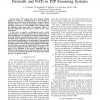Free Online Productivity Tools
i2Speak
i2Symbol
i2OCR
iTex2Img
iWeb2Print
iWeb2Shot
i2Type
iPdf2Split
iPdf2Merge
i2Bopomofo
i2Arabic
i2Style
i2Image
i2PDF
iLatex2Rtf
Sci2ools
IPPS
2010
IEEE
2010
IEEE
Modeling and analyzing the effects of firewalls and NATs in P2P swarming systems
Many P2P systems have been designed without taking into account an important factor: a large fraction of Internet users nowadays are located behind a network address translator (NAT) or a firewall, making them unable to accept incoming connections (i.e. unconnectable). Peers suffering from this limitation cannot fully enjoy the advantages offered by the P2P architecture and thus they are likely to get a poor performance. In this work, we present a mathematical model to study the performance of a P2P swarming system in the presence of unconnectable peers. We quantify the average download speeds of peers and find that unconnectable peers achieve a lower average download speed compared to connectable peers, and this difference increases hyperbolically as the percentage of unconnectable peers grows. More interestingly, we notice that connectable peers actually benefit from the existence of peers behind NATs/firewalls, since they alone can enjoy the bandwidth that those peers offer to the s...
Average Download Speed | Distributed And Parallel Computing | IPPS 2010 | Many P2P Systems | Unconnectable Peers |
| Added | 13 Feb 2011 |
| Updated | 13 Feb 2011 |
| Type | Journal |
| Year | 2010 |
| Where | IPPS |
| Authors | Lucia D'Acunto, Michel Meulpolder, Rameez Rahman, Johan A. Pouwelse, Henk J. Sips |
Comments (0)

